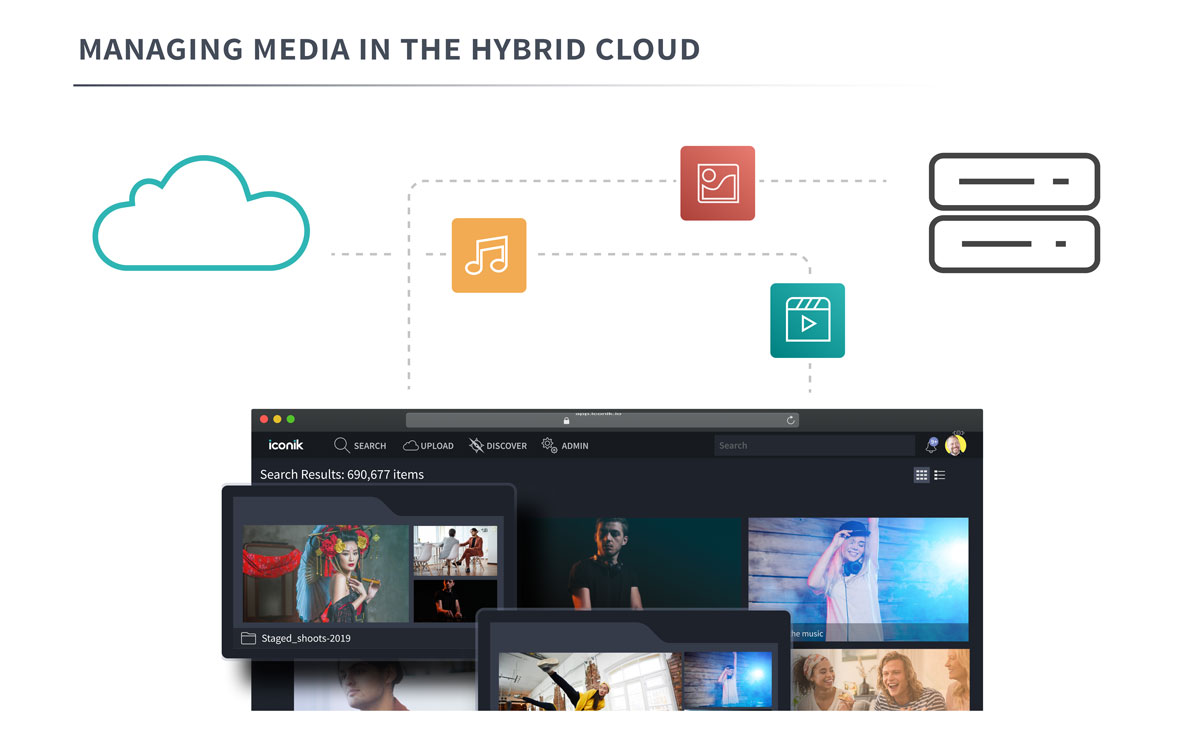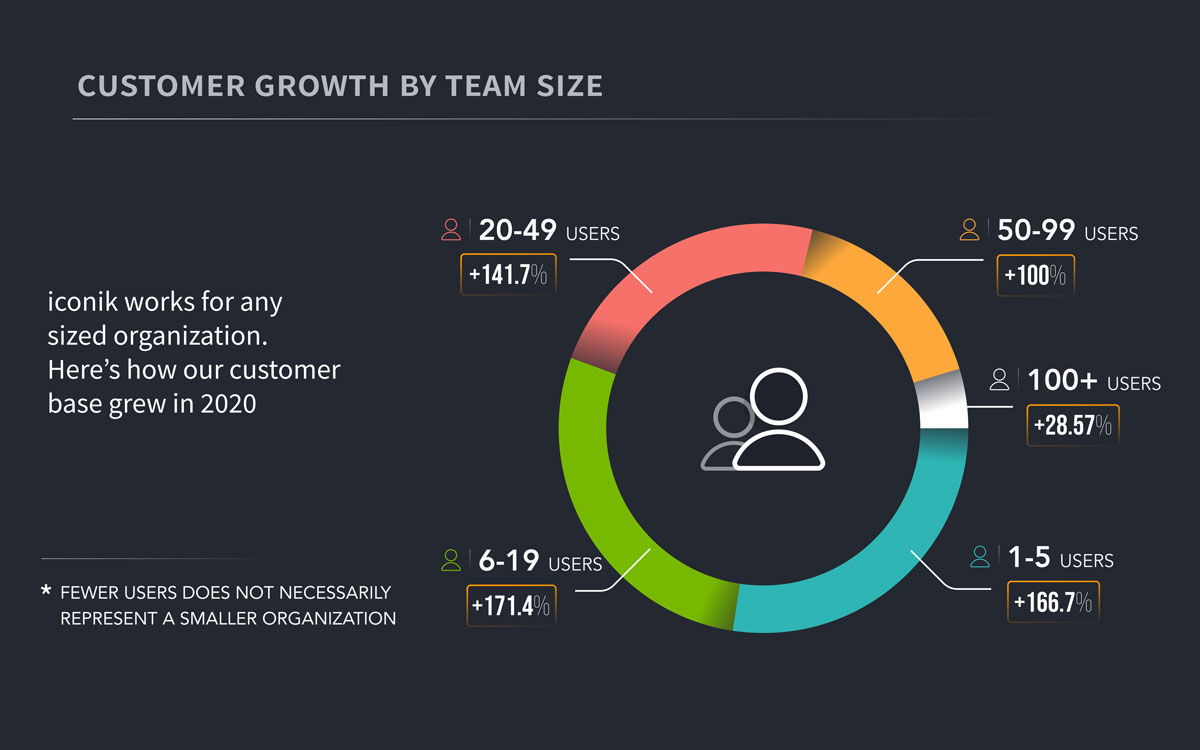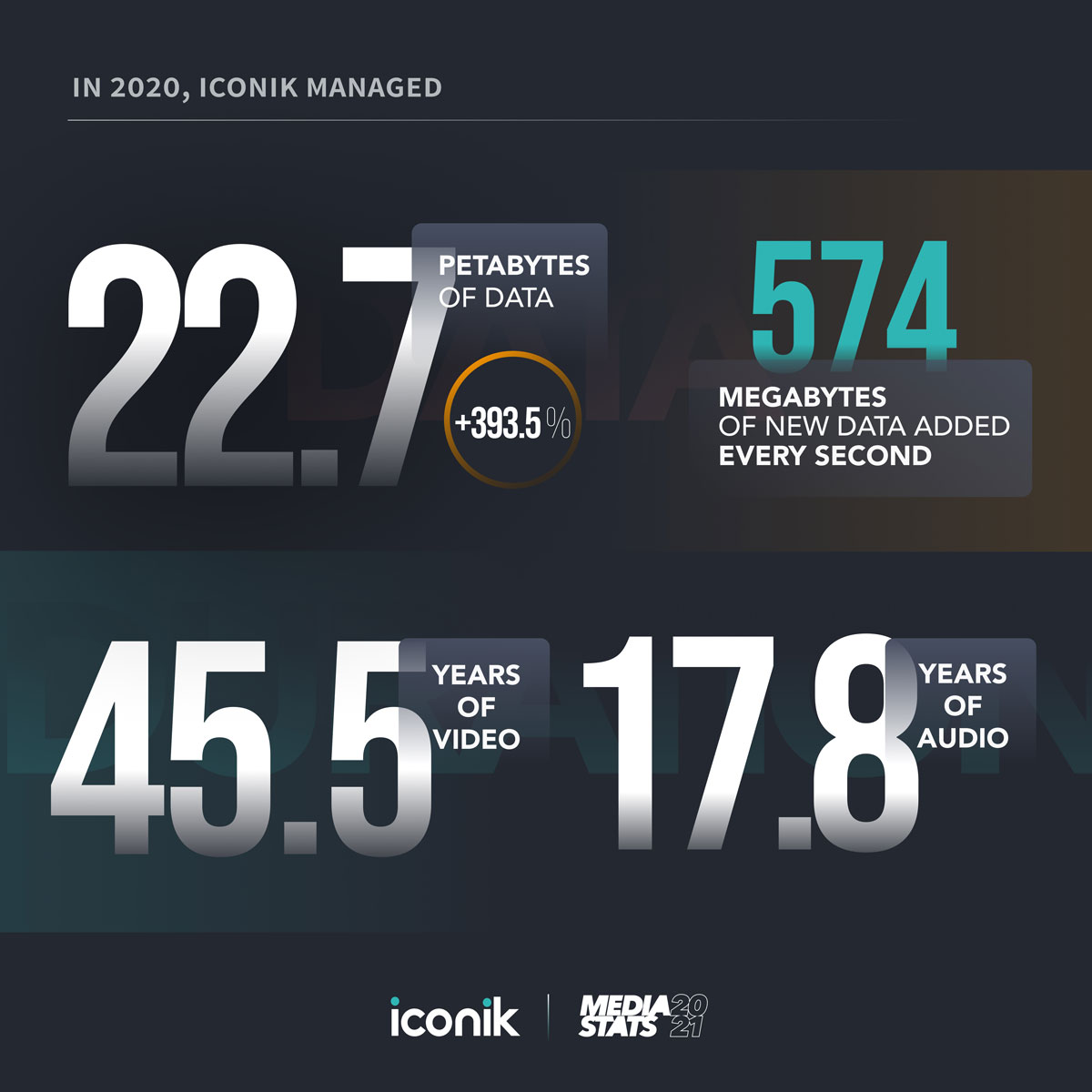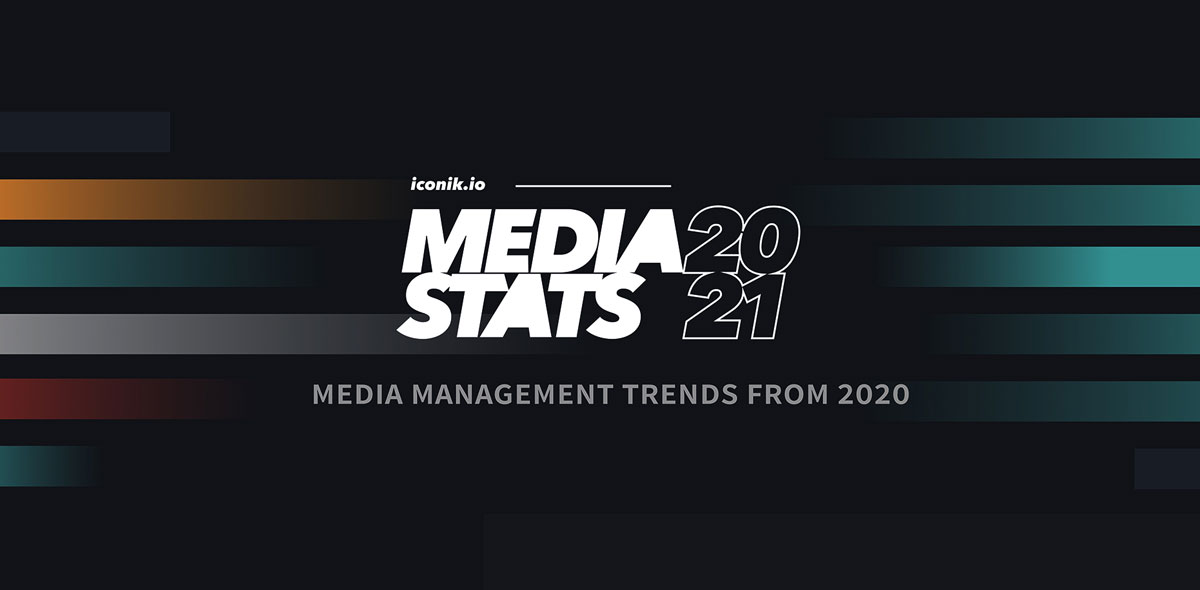TL;DR:
SaaS Media Management Adoption Increased as Remote Teams Used More Cloud Storage
- In 2020, the hybrid cloud split for iconik data was 64.6% cloud and 35.4% on-premise. This was an 11.6% rise in cloud data.
- 12.1 PB of data was added to the cloud in 2020, an increase of 490%.
- Amazon S3 ranks first in data storage with 37.8% of iconik’s data. It grew 1009% in 2020.
- Teams of 6-20 people adopted SaaS media management at a greater rate than any other size. iconik customers of this size grew 171%.
- The M&E space continued to lead in the adoption of SaaS media management. It represented 62% of the iconik customer base in 2020.
- Video represents 63% of iconik’s data, down 14.7% from 2019.
The Data Story Continues
Deep in the data, there’s a story. In our last Media Stats report, the story told us how Covid-19 had changed how people manage media. They relied more on cloud solutions at home than on hardware in the workplace.
At the end of 2020, more details of this story emerged.
Remote Teams Adopted SaaS Media Management to Manage More Cloud Content
A global health crisis made remote work a necessity. Organizations needed to access their media off-site, and many of them used new or existing cloud storage for this. The hybrid cloud allowed organizations to manage both cloud and on-premise storage, but cloud demand was higher in 2020—storing 11.8% more of the total data compared to the previous year.
Large media libraries needed to be organized for efficient productions and collaboration. More teams used SaaS media management to do this in 2020.

- More organizations have adopted SaaS media management. The number of iconik customers rose 151% across 12 industries in 2020.
- The hybrid cloud split in 2020 was 64.6% cloud and 35.4% on-premise compared to 53%/47% in 2019.
- The ISG generates proxy files, extracts technical metadata, and sends it all to the cloud to make on-premise content searchable and browsable from anywhere.
2020 Brought Massive Growth and Change to Cloud Storage
The rise in cloud data translated to 12.1 PB more content in the cloud— 490% more since 2019. That content was stored with many cloud storage services, but it looked very different than the year before.
In 2020 Amazon S3 Cloud Storage rose from #3 to the #1 storage provider. To do this, S3 grew an amazing 1009% to surpass IBM Cloud Storage, the #1 provider in 2019, and even the ISG. The ISG manages on-premise storage and accounts for nearly 33% of all data stored in iconik.
Backblaze B2 cloud storage also had impressive growth with a 933% increase. Our case studies for COMPLEX Networks and THEMA offer more background about this growth.

Here is how the 22.7 petabytes of iconik data was stored in 2020
- Amazon S3 holds the most storage with 37.8% of iconik’s data.
- Amazon S3 has grown 1009% since 2019
- Other cloud storage providers ranked by growth during 2020: Backblaze B2 = +933%, Google Cloud Storage =+429%, IBM Cloud Storage = +106%
- Recently, iconik has added end to end support for Azure Blob Storage. We expect noticeable growth for this category in 2021.
Smaller Teams Adopted SaaS Media Management More
Smaller teams took the lead in adopting SaaS media management. With the hybrid cloud, they could grow their media operations more rapidly with scalable resources in the cloud. Large organizations required more time to make the change.

- Media teams of 6-19 people grew 171%, having more growth than any other customer size.
- Smaller teams of 1-5 and midsize teams of 20-49 grew at a similar rate, while there was a noticeably slower growth rate for larger teams. This is in line with our expectations since larger teams usually take a longer time to adopt new workflows.
- Organic adoption growth was noticeable within teams. Many teams of 1-5 user teams have grown in 2020 and graduated to higher user tiers. This is a key trend that has happened as small teams pioneered new ways of working and paved the way for wider adoption.
Industry Adoption of the Hybrid Cloud Was Consistent
Media centric industries have always utilized media management the most, but non-traditional industries are finding their need for this too. SaaS solutions have made media management more accessible for everyone. Customer industries have become more diverse these past years, but 2020 did not have a great effect on this.
- Media and Entertainment remained the leader with 62% of iconik’s customer base, up 3% from 2019.
- The 2nd largest industry to adopt has been Public/Non-profit organizations, which make up 14% of iconik’s customer base.
- The largest noticeable industry change was a near 5% decline in both Consumer Discretionary and Information Technology industries.
iconik 2020 Data
In 2020, media teams from 12 industries used SaaS media management to manage content across multiple storage points, manage video projects online, facilitate collaboration around video, and edit video remotely. All this resulted in a massive wave of data.

Media Assets Rose with Video at the Helm
As teams became decentralized, they needed to make their media accessible for their organization. This meant they either had to add new content to cloud storage, or index existing cloud and on-premise storage in the cloud to make it searchable.
The result was a 477% rise in iconik assets.
What kind of assets were managed in 2020? In the chart below, you’ll see how many asset types were managed in iconik and how much data that created. Video remains the most common type of asset managed by SaaS media management services.
- iconik managed 55.4 million assets in 2020.
- This breakdown of assets has remained consistent with 2019.
- Even though video accounts for only 13% of the total number of assets in iconik, it makes up 63% of iconik’s data, down 14.7% from 2019.
Video Trends Held Steady
There have been big changes in video over the years, but 2020 video trends did not change much from 2019. There was more new video in 2020 which decreased the impact of older content on overall video statistics.
- The MPEG-4/H.264 label includes all MPEG 4 video and AVC in MOV and MXF containers. This includes formats like MP4, M4V, MKV, MOV and certain MXF videos.
- The amount of 1080p video rose 16% to 52.8%
- The amount of SD video dropped 33% in 2020.
- This indicates that there was more new content ingested and less archive content.
- 16:9 aspect ratio video increased 28% in 2020. 70% of the videos in iconik have this aspect ratio.
- The number of 3:2 aspect ratio videos dropped 32% in 2020. This is also a result of less archive content ingested.
Summary
SaaS media management solutions were already gaining traction in 2019. The events of 2020 only accelerated the adoption. Global brands and small production teams used the same solutions for media management because SaaS business models made products like iconik more accessible. Accessibility was also the reason why decentralized organizations needed the cloud to store more of their media in 2020.
As the data has grown, so has our commitment to those who depend on iconik. We’ve been honored to serve our customers this year.
Media Stats Methodology
What assets are counted? Only original assets added by our customers will be counted in our data—proxy and other files are excluded.
Is an asset the same as a file? No, an asset is a container that consists of at least two files. A single asset can include:
- A container
- An original file
- Various formats of that file, e.g. proxy, mezzanine, etc
- Technical and user-defined metadata (both on the asset and time-based level)
- ACLs (access control lists) and permissions
- And other files
How are industries defined? All industries are defined by the GICS model.
How do you track trends over time? All charts with a time axis have been generated using only files with the creation date set in the XMP or EXIF metadata. Files without a creation date have been omitted.

 Back to Blog
Back to Blog